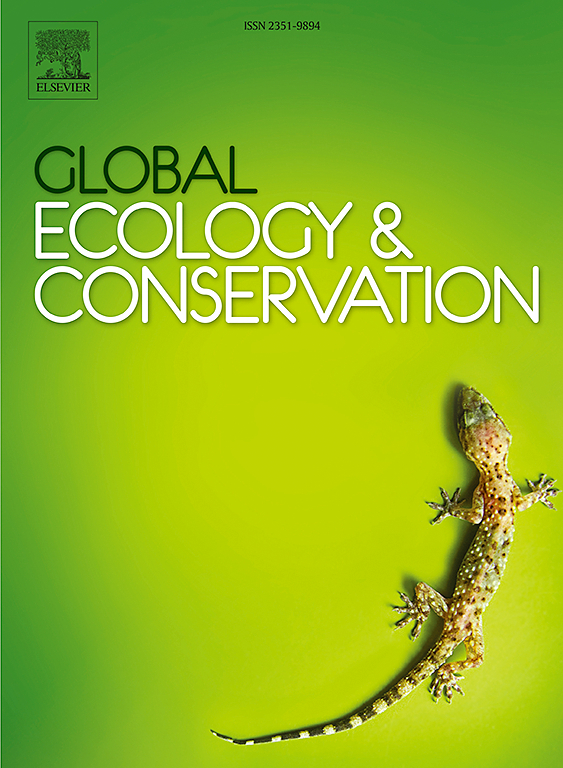Evaluating mangrove forest dynamics and fragmentation in Sundarbans, Bangladesh using high-resolution Sentinel-2 satellite images
IF 3.4
2区 环境科学与生态学
Q1 BIODIVERSITY CONSERVATION
引用次数: 0
Abstract
Forest fragmentation, caused by human activities, has negative consequences for forest health and biodiversity. The Sundarbans, situated in two densely populated countries, face ongoing human encroachment due to residential construction. This study investigated changes in forest cover and fragmentation in the Sundarbans, Bangladesh, from 2017 to 2023. The analysis used Sentinel-2 imagery and the Google Earth Engine (GEE) platform to classify water bodies, mangrove forests, built-up areas, and agriculture zones. Accuracy levels have not significantly fluctuated, but overall accuracy remained between 88 % and 91 %, with high agreement kappa statistics ranging from 0.83 to 0.88 across all years. The study identified Patch, Edge, Perforated, and Core forest classes, revealing annual shifts in land use. Notably, the ‘Patch’ class indicated localized regeneration, while the ‘Core (>202 ha)’ declined due to deforestation, urban expansion, and shifting agriculture. The Core class decreased significantly from 205,421 ha in 2017–73,127 ha in 2020. Additionally, Normalized Difference Vegetation Index (NDVI) indices highlighted fluctuations in forest classes and vegetation/non-vegetation areas. Canopy changes showed a 3 % reduction in high canopy (>0.3) from 2017 to 2023. High-resolution data facilitated the precise mapping of fragmented areas, emphasising the urgent need for conservation planning amidst urbanization while preserving the Sundarbans’ ecological integrity.
利用高分辨率Sentinel-2卫星图像评估孟加拉国孙德尔本斯红树林动态和破碎化
人类活动造成的森林破碎化对森林健康和生物多样性产生负面影响。孙德尔本斯位于两个人口稠密的国家,由于住宅建设而面临着人类不断的侵占。本研究调查了2017年至2023年孟加拉国孙德尔本斯森林覆盖和破碎化的变化。该分析使用Sentinel-2图像和谷歌地球引擎(GEE)平台对水体、红树林、建成区和农业区进行分类。准确率水平没有显著波动,但总体准确率保持在88 %和91 %之间,所有年份的高一致性kappa统计数据范围为0.83至0.88。该研究确定了斑块、边缘、穿孔和核心森林类别,揭示了土地利用的年度变化。值得注意的是,“斑块”类别表明局部再生,而“核心”(>202 ha)由于森林砍伐,城市扩张和农业转移而下降。核心类别从2017年的205,421 ha大幅减少到2020年的73,127 ha。此外,归一化植被指数(NDVI)指数突出了森林类别和植被/非植被区域的波动。冠层变化表明,2017 - 2023年,高冠层减少了3 % (>0.3)。高分辨率的数据有助于精确绘制破碎地区的地图,强调在城市化过程中迫切需要进行保护规划,同时保持孙德尔本斯的生态完整性。
本文章由计算机程序翻译,如有差异,请以英文原文为准。
求助全文
约1分钟内获得全文
求助全文
来源期刊

Global Ecology and Conservation
Agricultural and Biological Sciences-Ecology, Evolution, Behavior and Systematics
CiteScore
8.10
自引率
5.00%
发文量
346
审稿时长
83 days
期刊介绍:
Global Ecology and Conservation is a peer-reviewed, open-access journal covering all sub-disciplines of ecological and conservation science: from theory to practice, from molecules to ecosystems, from regional to global. The fields covered include: organismal, population, community, and ecosystem ecology; physiological, evolutionary, and behavioral ecology; and conservation science.
 求助内容:
求助内容: 应助结果提醒方式:
应助结果提醒方式:


